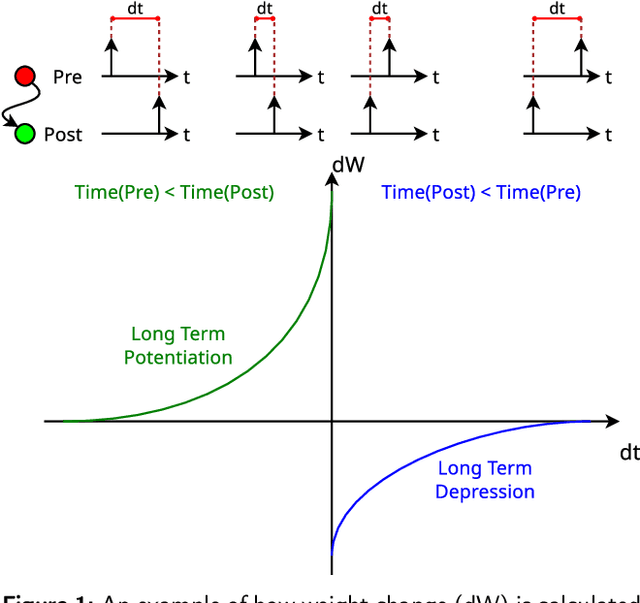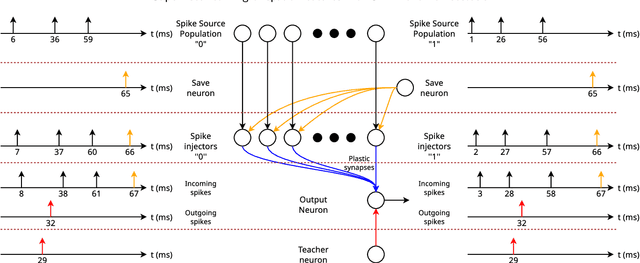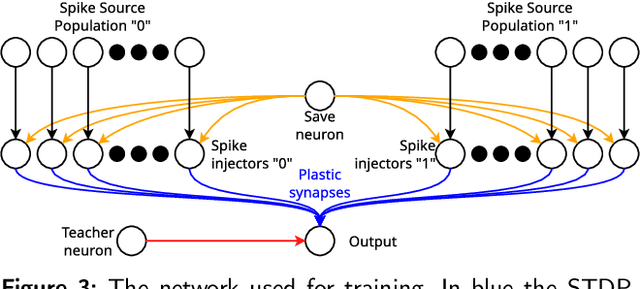Andrew Rowley
Supervised learning of spatial features with STDP and homeostasis using Spiking Neural Networks on SpiNNaker
Dec 05, 2023



Abstract:Artificial Neural Networks (ANN) have gained large popularity thanks to their ability to learn using the well-known backpropagation algorithm. On the other hand, Spiking Neural Networks (SNNs), despite having wider abilities than ANNs, have always presented a challenge in the training phase. This paper shows a new method to perform supervised learning on SNNs, using Spike Timing Dependent Plasticity (STDP) and homeostasis, aiming at training the network to identify spatial patterns. The method is tested using the SpiNNaker digital architecture. A SNN is trained to recognise one or multiple patterns and performance metrics are extracted to measure the performance of the network. Some considerations are drawn from the results showing that, in the case of a single trained pattern, the network behaves as the ideal detector, with 100% accuracy in detecting the trained pattern. However, as the number of trained patterns on a single network increases, the accuracy of the identification is linked to the similarities between these patterns. This method of training an SNN to detect spatial patterns may be applied on pattern recognition in static images or traffic analysis in computer networks, where each network packet represents a spatial pattern. It will be stipulated that the homeostatic factor may enable the network to detect patterns with some degree of similarities, rather than only perfectly matching patterns.
Measuring Air Quality via Multimodal AI and Satellite Imagery
Nov 01, 2022Abstract:Climate change may be classified as the most important environmental problem that the Earth is currently facing, and affects all living species on Earth. Given that air-quality monitoring stations are typically ground-based their abilities to detect pollutant distributions are often restricted to wide areas. Satellites however have the potential for studying the atmosphere at large; the European Space Agency (ESA) Copernicus project satellite, "Sentinel-5P" is a newly launched satellite capable of measuring a variety of pollutant information with publicly available data outputs. This paper seeks to create a multi-modal machine learning model for predicting air-quality metrics where monitoring stations do not exist. The inputs of this model will include a fusion of ground measurements and satellite data with the goal of highlighting pollutant distribution and motivating change in societal and industrial behaviors. A new dataset of European pollution monitoring station measurements is created with features including $\textit{altitude, population, etc.}$ from the ESA Copernicus project. This dataset is used to train a multi-modal ML model, Air Quality Network (AQNet) capable of fusing these various types of data sources to output predictions of various pollutants. These predictions are then aggregated to create an "air-quality index" that could be used to compare air quality over different regions. Three pollutants, NO$_2$, O$_3$, and PM$_{10}$, are predicted successfully by AQNet and the network was found to be useful compared to a model only using satellite imagery. It was also found that the addition of supporting data improves predictions. When testing the developed AQNet on out-of-sample data of the UK and Ireland, we obtain satisfactory estimates though on average pollution metrics were roughly overestimated by around 20\%.
 Add to Chrome
Add to Chrome Add to Firefox
Add to Firefox Add to Edge
Add to Edge